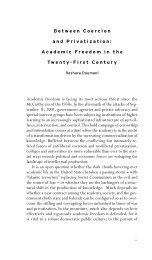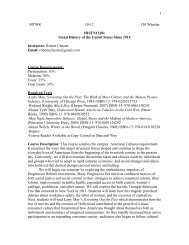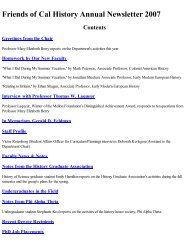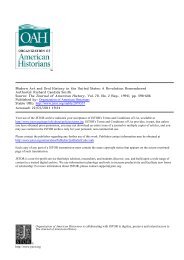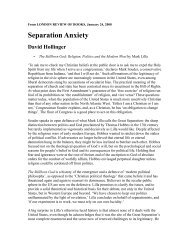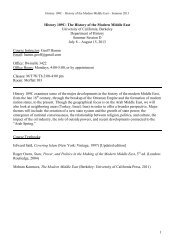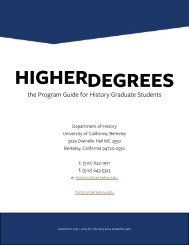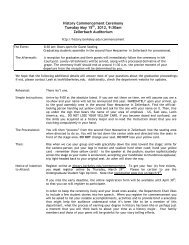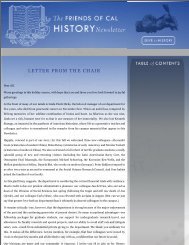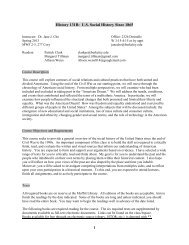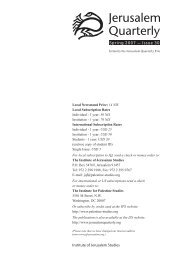history of denoting a permanent, physically embedded, "natural kind" is asked now to refer to contingent social relationships thatmany advocates of the word's continued use believe can <strong>and</strong> should be changed. In this context, some discussants (for example,Blum, "I'm Not a Racist," esp. 147–63) now refer to "racialized groups" instead of "races."55 Ê Farley, "Racial Issues," 126; Suro, "Mixed Doubles," 58.56 Ê Eva Saks, "Representing Miscegenation Law," Raritan 8 (Fall 1988): 39–69.57 Ê John D. Skrenty, <strong>The</strong> Minority Rights Revolution (New York, 2002). See also the essays collected in Skrentny, ed., Color Lines:Affirmative Action, Immigration, <strong>and</strong> Civil Rights Options for America (Chicago, 2001).58 Ê <strong>The</strong> somewhat different perspective advanced by leaders of African-American organizations in different periods is illustrated bythe praise black leaders of the late 1940s gave to Sinclair Lewis's Kingsblood Royal, a novel that was in fact based on the life of thelight-skinned Walter White, president of the National Association for the Advancement of Colored People. Although the novel'sdevastating critique of anti-black racism <strong>and</strong> the illogic of the one-drop rule found little white support, Lewis's implication thatblackness was a social construct was welcomed by many black Americans, as readers of the New York Times were recently remindedby Brent Staples, "When the Bard of 'Main Street' Turned the Kingsbood Family Black," New York Times (August 18, 2002): IV, 12.For a sound analysis of the novel <strong>and</strong> the difficulties white critics of the 1940s had in underst<strong>and</strong>ing it, see Jacobson, Whiteness of aDifferent Color, 265–71. Lewis in effect drew Norman Rockwell's family tree with a black face in it.59 Ê Michael Novak, <strong>The</strong> Rise of the Unmeltable Ethnics (New York, 1971).60 Ê <strong>The</strong> most influential intervention to this effect was Herbert Gans, "Symbolic Ethnicity," Ethnic <strong>and</strong> Racial Studies 2 (1979): 1–20.61 Ê It should be noted that the unique historical <strong>and</strong> constitutional situation of American Indians was widely recognized by Congress<strong>and</strong> the federal courts during this period, even while American Indians were commonly incorporated into the educational <strong>and</strong>entitlement programs described here. <strong>The</strong> passage in 1978 of the Indian Child Welfare Act is an example of Indian-specificmeasures developed during the 1970s.62 Ê Hugh Davis Graham, Collision Course: <strong>The</strong> Strange Convergence of Affirmative Action <strong>and</strong> Immigration Policy in America(New York, 2002); John D. Skrentny, "Affirmative Action <strong>and</strong> New Demographic Realities," Chronicle of Higher Education(February 16, 2001).63 Ê One Republican senator attempting to discredit all of Affirmative Action observed that the wealthiest monarch in the world, theBorneo-based sultan of Brunei, would be in principle eligible for Affirmative Action if he immigrated to the United States. For thisincident, <strong>and</strong> for an analysis of the decision of most Republicans to live with Affirmative Action despite its lack of popularity withvoters, see John D. Skrentny, "Republican Efforts to End Affirmative Action: Walking a Fine Line," in Martin A. Levin, et al.,Seeking the Center: Politics <strong>and</strong> Policymaking at the New Century (Washington, D.C., 2001), 132–71. For examples of presscoverage of European immigrants (especially from Portugal) who obtained contracts under Affirmative Action programs, seeGraham, Collision Course, 154–55.64 Ê Just how far the need to clarify the basis for entitlements for non-blacks was from almost everyone's mind is indicated by thecharacter of the discussion that took place in 1965 at the single hearing held by the Equal Employment Opportunity Commission onEEO–1, the precedent-setting employer reporting form that became the model for later Affirmative Action documents throughoutfederal <strong>and</strong> state officialdoms <strong>and</strong> in the private sector. Although this form was defined by the four classic "minorities" of theethnoracial pentagon that were made general to the entire federal bureaucracy in 1977 through the legendary Statistical DirectiveNo. 15 of the Office of Management <strong>and</strong> Budget, no voice at the hearing commented even in passing on the non-black minorities.Everyone assumed the non-black groups to be so tiny a part of the picture as to require no discussion <strong>and</strong> to entail no policydilemmas in the future. I owe this information about the EEOC hearing to John D. Skrentny.65 Ê A prominent example of a vigorous mid-1990s defense of Affirmative Action that avoids the issue of immigrant eligibility isStephen Steinberg, Turning Back: <strong>The</strong> Retreat from Racial Justice in American Thought <strong>and</strong> Policy (Boston, 1995). Steinberg dealsextensively with immigration, which he sees as largely damaging to African Americans. But he treats Affirmative Action itself as ifit applied only to African Americans, <strong>and</strong> thus his arguments for its perpetuation, which are grounded in an analysis of the history ofthat single group, do not speak directly to the specific programs that were being diminished <strong>and</strong> abolished.
66 Ê This article was completed before the appearance of Peter Kolchin's judicious "Whiteness Studies: <strong>The</strong> New History of Race inAmerica," Journal of American History 89 (June 2002): 154–73. It is possible that more attention to the history of ethnoracialmixture can consolidate the historiographical advances Kolchin summarizes <strong>and</strong> address more forthrightly some of the desiderata heidentifies.67 Ê Yet the concept of assimilation, long maligned, is now being defended in ways that better enable it to convey part of the story Iam calling "amalgamation." See Russell A. Kazel, "Revisiting Assimilation: <strong>The</strong> Rise, Fall, <strong>and</strong> Reappraisal of a Concept inAmerican Ethnic History," AHR 100 (April 1995): 437–71; Richard Alba, "Assimilation's Quiet Tide," Public Interest (Spring 1995);Alej<strong>and</strong>ro Portes <strong>and</strong> Ruben G. Rumbaut, Legacies: <strong>The</strong> Story of the Immigrant Second Generation (Berkeley, Calif., 2001), esp.chap. 3, "Not Everyone Is Chosen: Segmented Assimilation <strong>and</strong> Its Determinants," 44–69.68 Ê Out-marriage rates differ considerably within these color-coded descent groups. About 60 percent of persons of Cuban <strong>and</strong>Puerto Rican ancestry born in the United States marry non-Latino spouses. Persons of Filipino <strong>and</strong> Korean ancestry born in theUnited States acquire non-Asian spouses at about the same rate. Mexican <strong>and</strong> Chinese out-marriage rates are lower. See Jerry Jacobs<strong>and</strong> Teresa Labov, "Gender Differentials in Intermarriage among Sixteen Race <strong>and</strong> Ethnic Groups," Sociological Forum(forthcoming, 2003).69 Ê Farley, "Racial Issues," 126.70 Ê For the 1940 figure, see Arthur Goren, "Jews," Harvard Encyclopedia of American Ethnic Groups (Cambridge, Mass., 1980),596; for 1990, see Seymour Martin Lipset <strong>and</strong> Earl Raab, Jews <strong>and</strong> the New American Scene (Cambridge, Mass., 1995), 72. Lipset<strong>and</strong> Raab rely on the National Jewish Population Study of 1990, which reported that 57 percent of the Jews who had married duringthe five years previous to 1990 had married non-Jews.71 Ê Farley, "Racial Issues," 126.72 Ê That black-white marriages had increased by about 70 percent during the decade of the 1990s was reported by the CensusBureau in its report "Interracial Married Couples," June 29, 2001: in 1990, there were 211,000 black-white married couples, <strong>and</strong> in2000 there were 363,000.73 Ê R<strong>and</strong>all Kennedy critically discusses disagreements among African Americans concerning mixture-related issues in "InterracialIntimacy," Atlantic (December 2002): 103–10.74 Ê For a defense of the idea that "miscegenation comes close to epitomizing the American experience," in both Latin America <strong>and</strong>North America, see Earl E. Fitz, "From Blood to Culture: Miscegenation as Metaphor for the Americas," in Monika Kaup <strong>and</strong> DebraJ. Rosenthal, eds., Mixing Race, Mixing Culture: Inter-American Literary Dialogues (Austin, Tex., 2002), 243–72, esp. 244. Thishemisphere-centered analysis is also an example of the continued use in some quarters of "miscegenation" as a neutral term.75 Ê Frederick Jackson Turner, "<strong>The</strong> Significance of the Frontier in American History" [1893], rpt. in Fulmer Mood, ed., <strong>The</strong> EarlyWritings of Frederick Jackson Turner (Madison, Wis., 1938), 183–232. My underst<strong>and</strong>ing of the historical significance of the Turnerthesis has been influenced by Kerwin L. Klein, Frontiers of Historical Imagination: Narrating the European Conquest of NativeAmerica, 1890–1990 (Berkeley, Calif., 1997).76 Ê Although specialized studies consistent with this view of the history of the United States abound, attempts at synthesis remainrare. One breezy but helpfully provocative effort to outline a national story emphasizing the theme of amalgamation, offered franklyas a "speculation," is in the final chapter of Michael Lind, <strong>The</strong> Next American Nation: <strong>The</strong> New Nationalism <strong>and</strong> the FourthAmerican Revolution (New York, 1995), 352–88.77 Ê I have argued for the centrality of this issue in "How Wide the Circle of the We: American Intellectuals <strong>and</strong> the Problem of theEthnos since World War II," AHR 98 (April 1993): 317–37; <strong>and</strong> Postethnic America: Beyond Multiculturalism, 2d edn., exp<strong>and</strong>ed(New York, 2000).78 Ê Herman Melville, Redburn (London, 1986), 240. See also Acts 2: 1–21.79 ÊBulworth, a film by Warren Beatty, 1998.



